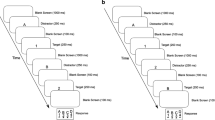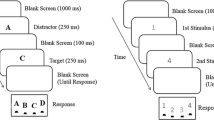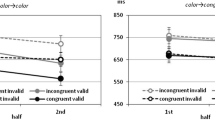Abstract
In the present study, we followed up on a recent report of two experiments in which the congruency sequence effect—the reduction of the congruency effect after incongruent relative to congruent trials in Stroop-like tasks—was observed without feature repetition or contingency learning confounds. Specifically, we further scrutinized these data to determine the plausibility of a temporal learning account as an alternative to the popular conflict adaptation account. To this end, we employed a linear mixed effects model to investigate the role of previous response time in producing the congruency sequence effect, because previous response time is thought to influence temporal learning. Interestingly, slower previous response times were associated with a reduced current-trial congruency effect, but only when the previous trial was congruent. An adapted version of the parallel episodic processing (PEP) model was able to fit these data if it was additionally assumed that attention “wanders” during different parts of the experiment (e.g., due to fatigue or other factors). Consistent with this assumption, the magnitude of the congruency effect was correlated across small blocks of trials. These findings demonstrate that a temporal learning mechanism provides a plausible account of the congruency sequence effect.



Similar content being viewed by others
Notes
Figure 1 roughly illustrates why the parallel episodic processing model, discussed later, produces a larger effect of expectancy-based changes in the response threshold for congruent relative to incongruent trials. The point at which evidence for a response will begin to increase and the steepness of the slope of increasing activation will vary from trial to trial within both the congruent and incongruent conditions. The evolution of the response threshold over time will also vary from trial to trial depending on the speed of responding in the last few trials. However, the figure demonstrates why, generally, congruent trials are more affected than incongruent trials by expectancies following fast congruent relative to slow incongruent responses. Congruent trials will generally benefit from a fast expectancy, but will “beat” the response threshold dip with a slow expectancy. In contrast, incongruent trials will not only benefit from slow expectancies, but will also often be fast enough to benefit from a fast expectancy.
References
Abrahamse, E., & Braem, S. (2015). Experience a conflict—either consciously or not (commentary on Desender, Van Opstal, and Van den Bussche, 2014). Frontiers in Psychology, 6, 179.
Blais, C., Stefanidi, A., & Brewer, G. (2014). The Gratton effect remains after controlling for contingencies and stimulus repetitions. Frontiers in Psychology, 5, 1207.
Boksem, M. A. S., Meijman, T. F., & Lorist, M. M. (2005). Effects of mental fatigue on attention: an ERP study. Cognitive Brain Research, 25, 107–116.
Botvinick, M. M., Braver, T. S., Barch, D. M., Carter, C. S., & Cohen, J. D. (2001). Conflict monitoring and cognitive control. Psychological Review, 108, 624–652.
Botvinick, M. M., Nystrom, L. E., Fissell, K., Carter, C. C., & Cohen, J. D. (1999). Conflict monitoring versus selection-for-action in anterior cingulate cortex. Nature, 402, 179–181.
Burle, M. S., van den Wildenberg, W. P. M., & Ridderinkhof, K. R. (2005). Dynamics of facilitation and interference in cue-priming and Simon tasks. European Journal of Cognitive Psychology, 17, 619–641.
Compton, R. J., Huber, E., Levinson, A. R., & Zheutlin, A. (2012). Psychophysiology, 49, 583–589.
Desender, K., Van Opstal, F., & Van den Bussche, E. (2014). Feeling the conflict: the crucial role of conflict experience in adaptation. Psychological Science, 25, 675–683.
Duthoo, W., Abrahamse, E. L., Braem, S., Boehler, C. N., & Notebaert, W. (2014). The congruency sequence effect 3.0: a critical test of conflict adaptation. PLoS ONE, 9, e110462.
Egner, T. (2007). Congruency sequence effects and cognitive control. Cognitive, Affective, & Behavioral Neuroscience, 7, 380–390.
Eriksen, B. A., & Eriksen, C. W. (1974). Effects of noise letters upon the identification of a target letter in a nonsearch task. Perception and Psychophysics, 16, 143–149.
Gratton, G., Coles, M. G. H., & Donchin, E. (1992). Optimizing the use of information: strategic control of activation of responses. Journal of Experimental Psychology: General, 121, 480–506.
Grice, G. R. (1968). Stimulus intensity and response evocation. Psychological Reviewer, 75, 359–373.
Grinband, J., Savitskaya, J., Wager, T. D., Teichert, T., Ferrera, V. P., & Hirsch, J. (2011). Conflict, error likelihood, and RT: response to Brown & Yeung. NeuroImage, 57, 320–322.
Grosjean, M., Rosenbaum, D. A., & Elsinger, C. (2001). Timing and reaction time. Journal of Experimental Psychology: General, 130, 256–272.
Hazeltine, E., Akçay, Ç., & Mordkoff, J. T. (2011). Keeping Simon simple: examining the relationship between sequential modulations and feature repetitions with two stimuli, two locations and two responses. Acta Psychologica, 136, 245–252.
Hommel, B., Proctor, R. W., & Vu, K.-P. L. (2004). A feature-integration account of sequential effects in the Simon task. Psychological Research, 68, 1–17.
Jensen, A. R. (1992). The importance of intraindividual variation in reaction time. Personality and Individual Differences, 13, 869–881.
Jiménez, L., & Méndez, A. (2012). It is not what you expect: dissociating conflict adaptation from expectancies in a Stroop task. Journal of Experimental Psychology: Human Perception and Performance, 39, 271–284.
Kim, S., & Cho, Y. S. (2014). Congruency sequence effect without feature integration and contingency learning. Acta Psychologica, 149, 60–68.
Kinoshita, S., Forster, K. I., & Mozer, M. C. (2008). Unconscious cognition isn’t that smart: modulation of masked repetition priming effect in the word naming task. Cognition, 107, 623–649.
Kinoshita, S., Mozer, M. C., & Forster, K. I. (2011). Dynamic adaptation to history of trial difficulty explains the effect of congruency proportion on masked priming. Journal of Experimental Psychology: General, 140, 622–636.
Kohfeld, D. L. (1968). Stimulus intensity and adaptation level as determinants of simple reaction time. Journal of Experimental Psychology, 76, 468–473.
Kornblum, S., Hasbroucq, T., & Osman, A. (1990). Dimensional overlap: cognitive basis for stimulus-response compatibility—a model and taxonomy. Psychological Review, 97, 253–270.
Lamers, M. J. M., & Roelofs, A. (2011). Attentional control adjustments in Eriksen and Stroop task performance can be independent of response conflict. Quarterly Journal of Experimental Psychology, 64, 1056–1081.
Mayr, U., Awh, E., & Laurey, P. (2003). Conflict adaptation effects in the absence of executive control. Nature Neuroscience, 6, 450–452.
Mordkoff, J. T. (2012). Observation: three reasons to avoid having half of the trials be congruent in a four-alternative forced-choice experiment on sequential modulation. Psychonomic Bulletin & Review, 19, 750–757.
Ollman, R. T., & Billington, M. J. (1972). The deadline model for simple reaction times. Cognitive Psychology, 3, 311–336.
Ridderinkhof, K. R. (2002). Activation and suppression in conflict tasks: empirical clarification through distributional analyses. In W. Prinz & B. Hommel (Eds.), Common mechanisms in perception and action. Attention and performance (Vol. XIX, pp. 494–519). Oxford: Oxford University Press.
Schmidt, J. R. (2013a). Questioning conflict adaptation: proportion congruent and Gratton effects reconsidered. Psychonomic Bulletin & Review, 20, 615–630.
Schmidt, J. R. (2013b). Temporal learning and list-level proportion congruency: conflict adaptation or learning when to respond? PLoS ONE, 8, e82320.
Schmidt, J. R. (2013c). The parallel episodic processing (PEP) model: dissociating contingency and conflict adaptation in the item-specific proportion congruent paradigm. Acta Psychologica, 142, 119–126.
Schmidt, J. R. (2014). Contingency and congruency switch in the congruency sequence effect: a reply to Blais, Stefanidi, and Brewer (2014). Frontiers in Psychology, 5, 1405.
Schmidt, J. R., & De Houwer, J. (2011). Now you see it, now you don’t: controlling for contingencies and stimulus repetitions eliminates the Gratton effect. Acta Psychologica, 138, 176–186.
Schmidt, J. R., De Schryver, M., & Weissman, D. H. (2014a). Removing the influence of feature repetitions on the congruency sequence effect: why regressing out confounds from a nested design will often fall short. Journal of Experimental Psychology: Human Perception and Performance, 40, 2392–2402.
Schmidt, J. R., Lemercier, C., & De Houwer, J. (2014b). Context-specific temporal learning with non-conflict stimuli: proof-of-principle for a learning account of context-specific proportion congruent effects. Frontiers in Psychology, 5, 1241.
Schmidt, J. R., Notebaert, W., & Van Den Bussche, E. (2015). Is conflict adaptation an illusion? Frontiers in Psychology, 6, 172.
Schmidt, J. R., & Weissman, D. H. (2014). Congruency sequence effects without feature integration or contingency learning confounds. PLoS ONE, 9, e0102337.
Simon, J. R., & Rudell, A. P. (1967). Auditory S-R compatibility: the effect of an irrelevant cue on information processing. Journal of Applied Psychology, 51, 300–304.
Smallwood, J., McSpadden, M., Luus, B., & Schooler, J. (2008). Segmenting the stream of consciousness: the psychological correlates of temporal structures in the time series data of a continuous performance task. Brain and Cognition, 66, 50–56.
Smallwood, J., & Schooler, J. W. (2006). The restless mind. Psychological Bulletin, 132, 946–958.
Stroop, J. R. (1935). Studies on interference in serial verbal reactions. Journal of Experimental Psychology, 18, 643–662.
Weissman, D. H., & Carp, J. (2013). Congruency sequence effects are driven by previous-trial congruency, not previous-trial response conflict. Frontiers in Psychology, 4, 587.
Weissman, D. H., Egner, T., Hawks, Z., & Link, J. (2015). The congruency sequence effect emerges when the distracter precedes the target. Acta Psychologica, 156, 8–21.
Weissman, D. H., Jiang, J., & Egner, T. (2014). Determinants of congruency sequence effects without learning and memory confounds. Journal of Experimental Psychology: Human Perception and Performance, 40, 2022–2037.
Wylie, S. A., Ridderinkhof, K. R., Bashore, T. R., & van den Wildenberg, W. P. M. (2010). The effect of Parkinson’s disease on the dynamics of on-line and proactive cognitive control during action selection. Journal of Cognitive Neuroscience, 22, 2058–2073.
Yeung, N., Cohen, J. D., & Botvinick, M. M. (2011). Errors of interpretation and modeling: a reply to Grinband. NeuroImage, 57, 316–319.
Acknowledgments
This research was supported by start-up funds from the University of Michigan awarded to Daniel H. Weissman. James R. Schmidt is a postdoctoral researcher of the Research Foundation—Flanders (FWO—Vlaanderen). The authors would like to thank Tobias Egner, Antonio Freitas, Toby Mordkoff, Timothy Verstynen, and Yanni Liu for useful discussions related to this research.
Author information
Authors and Affiliations
Corresponding author
Rights and permissions
About this article
Cite this article
Schmidt, J.R., Weissman, D.H. Congruency sequence effects and previous response times: conflict adaptation or temporal learning?. Psychological Research 80, 590–607 (2016). https://doi.org/10.1007/s00426-015-0681-x
Received:
Accepted:
Published:
Issue Date:
DOI: https://doi.org/10.1007/s00426-015-0681-x




